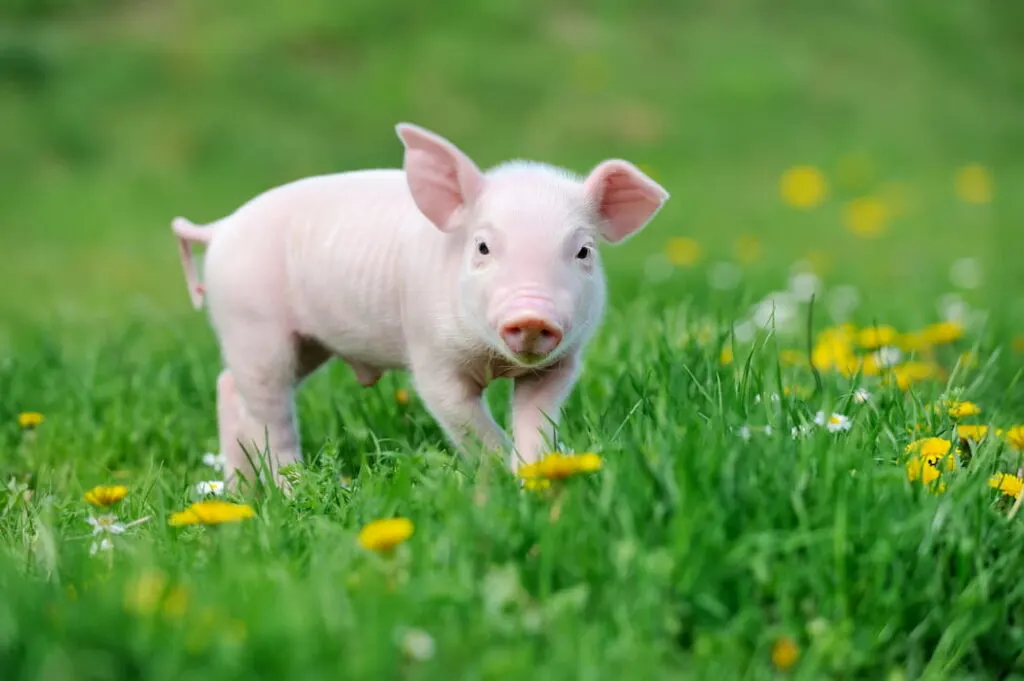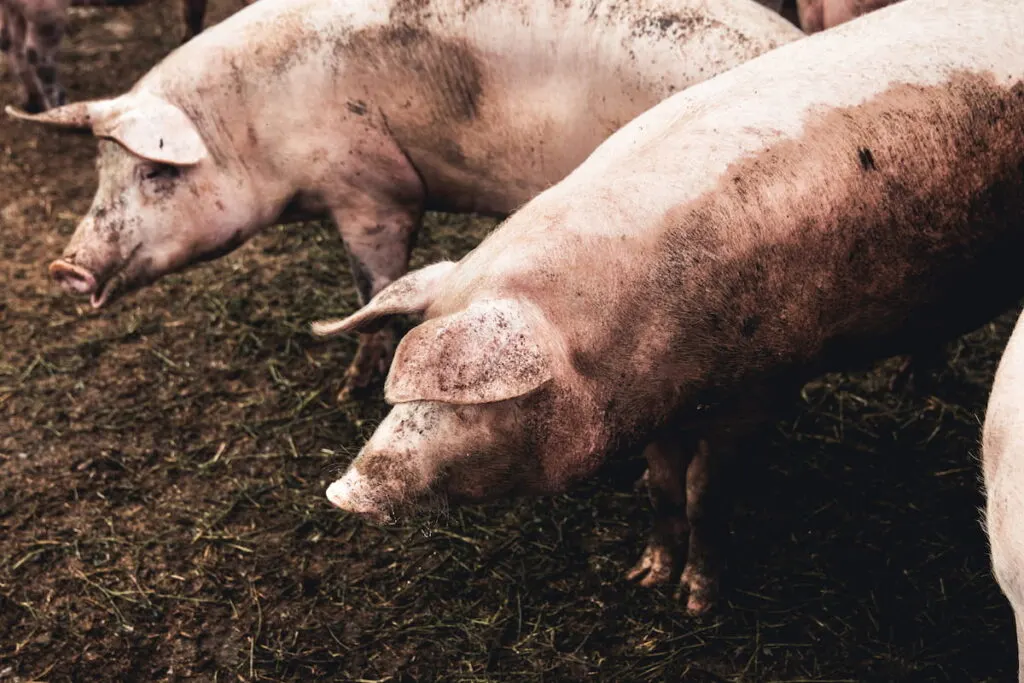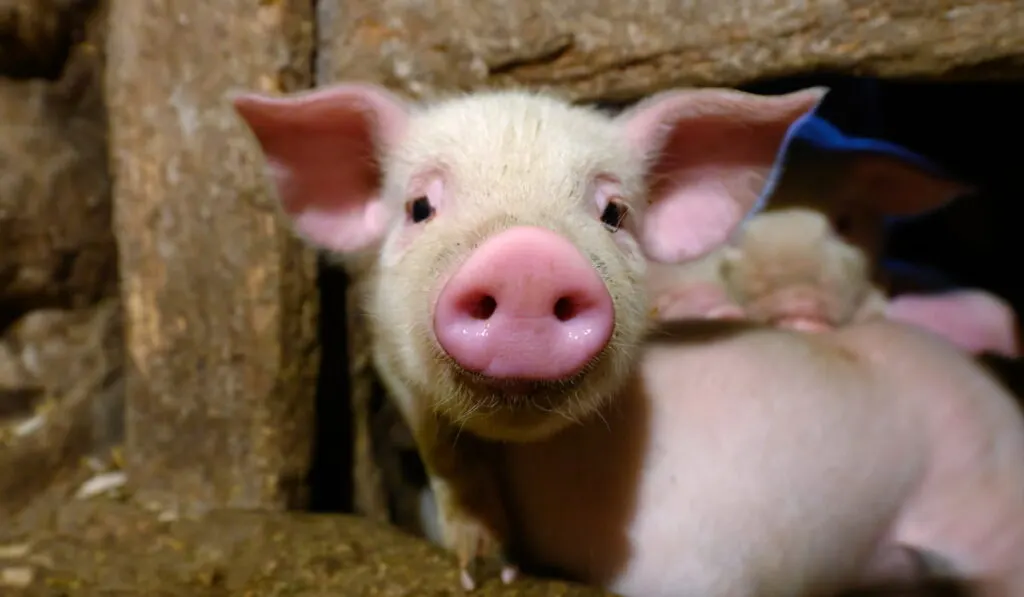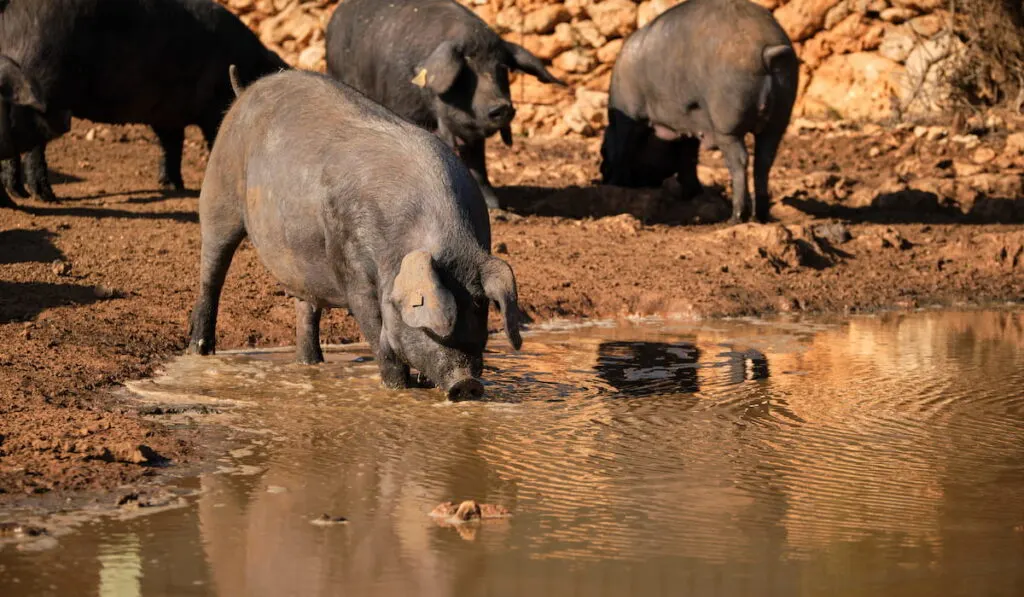Why would a pig be shaking/shivering?
It’s natural to question if your pigs may get cold, especially when winter is fast approaching.
Despite the fact that their bodies are engineered to tolerate the cold better than humans, they do get cold, and shivering and shaking is an obvious sign of a cold pig.
They, therefore, require extra warmth, especially piglets and mini-pigs, when approaching, and in the cold months of the year.
Statistically, sows thrive in temperatures of 60 – 65 degrees Fahrenheit.
Piglets and other pigs, however, require a higher temperature of at least 80 degrees for their optimal functioning.
Besides cold, shivering for both piglets and grown-up pigs could be a sign of viral infections like Atypical Porcine Pestivirus (APPV), and could be the leading sign for the diagnosis of this fatal virus.

This virus can be hosted in a pig’s body for a long time and could be sexually transmitted.
Unlike humans, animals are meant to keep their bodies warm because they have fur.
Pigs have little fur on their body but are endowed with a thick layer of adipose fat beneath their skin, which plays the same role as fur and wool, and helps keep the pig warm.
Despite this, pigs still need shelter when it gets extremely cold, evidenced by shivering. Piglets do not develop this thick adipose fat layer until their maturity so they need more help to keep warm.
How to tell if a pig is cold
In most cases, pigs generate their own heat, and you can even see steam coming out of their bodies in cold weather.
But they can become ill when they are exposed to extremely cold conditions, since they are also susceptible to pneumonia, frostbite, and hypothermia, including respiratory problems.
A cold pig will have shifts on how well it will eat and process its food.
It doesn’t matter how well you have been feeding your pig and how effective the feeds were before, when exposed to freezing temperature for a long time, the functions of the gut are slowed and food may not be processed well.
The pig may lose its appetite and eat less as compared to before. Concurrently, they will produce less body heat get more susceptible to the extreme cold.
Besides shaking and shivering, other signs of a cold pig you would want to watch out for are snorting and coughing.
Other physical signs include changes in texture and skin color, like reddening of the skin, which could be a whistleblower.
Sunken eyes are also an indication of an impending illness, and providing warmth should be the first step in addressing this.

How to tell if a pig has a fever
For pigs, fever (high body temperature) is mostly associated with viral or bacterial infections, and rarely stress, and may be accompanied by little or no other symptoms.
Pigs with fevers often have a temperature ranging from 102.2-104 degrees Fahrenheit.
The common signs to watch out to identify a pig with fever include general dullness in a pig and sometimes reddening of the skin. Another symptom may be raised respiratory rates.
Medical examinations from a certified vet should help pinpoint the exact cause of the temperature spike with the obvious reasons prioritized.
Fever should not be taken lightly and calls for a serious medical examination to check for the conditions that could lead to serious illnesses.
You should also bear in mind that fever, depending on the world and your environment, is always the first clinical sign of complications and diseases like African Swine-Fever, Classical Swine Fever, and Aujeszky’s disease (pseudorabies).
Among the common causes of fever in pigs is mastitis or metritis, secondary infections accompanying flu or PRRS, cystitis/pyelonephritis, retention of a dead pig, bacterial septicemia such as erysipelas, heatstroke, and acute stress or eclampsia.
On the bright side, fever can be cured for pigs using broad-spectrum antibiotics such as trimethoprim/sulpha, oxytetracycline, penicillin/streptomycin, and amoxicillin.

How to keep pigs warm
As mentioned before, mature pigs can generate their own body heat with their thick adipose layer, but this may not be enough during the cold season.
The farmer is therefore required to provide extra warmth to the pig to ensure optimal conditions for the pigs to thrive. Let’s take a look at a few points to consider.
- Provide shelter – the usual pig-shelter setup is fine, though some may want to get on an insulated setup.
Different farmers will, however, choose differently, depending on the type of pigs they have, how trained they are, and how cold could the weather will get.
Extremely cold weather requires insulated shelters for pigs, while the normal shelters work well for fairly warm conditions.
Raised shelters are a plus for boosting warmth in the shelter because groundwater could be a contributing factor to the cold.
Proper ventilation should be stressed in a pig shelter to ensure good airflow for the pigs, and in turn, makes them comfortable in the shelter even if it gets hot.
- Choose appropriate bedding – the pig bedding is meant to keep the pig dry from any dampness.
Most pig beddings are made of thick layers of straw that are effective in insulating them from the ground.
Compared to regular-sized and grown-up pigs, piglets are far more sensitive and have their own bedding requirements.
To ensure maximum warmth, you could do combinations of several bedding materials.
Remember to be careful not to over-insulate the pigs to avoid other risks that could accompany over-insulation, especially when you have a litter of pigs that snuggle with each other.
Those are basically able to generate and share enough heat without help.
Deeply bedded pig pens with microbes beneath are also good for a bedding choice.
They decompose organic material in the bedding, mineralizing the nutrients, and in turn, release heat that warms up the pigs from beneath.
Advantageously, microbes also eat and decompose pathogens in the bedding that would otherwise be dangerous to the herd.

- Keep them hydrated – when pigs get dehydrated, they get more prone and susceptible to infections and illnesses.
This implies that to reduce the chances of illnesses and infections during the cold season, you have to pay more attention to their water supply.
For the outdoor pigs, constantly check to ensure that their water doesn’t freeze. - Keep them dry and clean – the cold weather outside should be a motivating factor for you to keep your pigs dry and clean during winter.
Their bedding and general living space should also be kept clean and dry just to help avoid catching a cold and infections.
Cold and dirty pig shelters are no doubt a haven for breeding infections. - Use heaters and heat lamps – heaters and heat lamps are a wise investment decision, especially when you have pigs and mini-pigs, who are not essentially built for harsh weather.
Piglets have thinner skin and have not yet developed the insulative adipose layer, so they need external help to stay warm.
Whenever they get too hot, piglets often move away themselves when they feel satisfied with the heat.
Precautions should be taken when using heat lamps since there have been reported instances of pig beddings catching fire because the lamps were left on for too long and ended lighting up the bedding.
You should distance the lamp enough not to do such damage, or keep an eye on it yourself, ensuring you turn it off when you leave the pigs’ space.
- Maintain your routine – cold weather doesn’t mean that you should leave the pigs to snuggle all day and live by themselves.
You should continue exercising and training them on a daily basis to keep them physically and mentally fit, and also reduce the chances of infections and sicknesses.
Keeping their energy levels up also prevents them from getting lazy.
Conclusion
Pigs can naturally handle cold weather, but the extreme cold could overwhelm them, causing them to shake and shiver a lot, just like humans when cold.
Shivering is, however, not always a sign of a cold pig, as some viral and bacterial infections could cause the pig to shiver, which could be the first sign of infection.
It is always good to take precautionary measures when you notice abnormal behavior like shaking and shivering, such as providing heating or warm options for your pigs.
If the shivering persists even after the first-hand remedies, it is always good to inform a qualified and licensed vet to do the diagnosis and give details of the situation.
Resources
- https://www.pigprogress.net/Health/Health-Tool/diseases/Hypothermia/
- https://www.sciencedaily.com/releases/2017/01/170113090450.htm
- https://nadis.org.uk/disease-a-z/pigs/congenital-tremor/
- https://petpigworld.com/do-pigs-get-cold/
- https://extension.psu.edu/cold-temperature-management-for-pigs
- https://resources.bestfriends.org/article/potbellied-pig-health-and-sickness
- https://www.thepigsite.com/disease-guide/fever
- https://www.thepigsite.com/articles/pigs-in-blankets-how-to-keep-your-pigs-warm-in-winter
- https://www.hobbyfarms.com/how-to-keep-piglets-warm-naturally/
